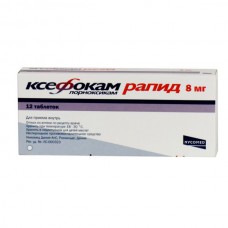Expiration date: 02/2026
The composition and form of issue:
Tablets, film-coated. 1 tablet contains active substance:
lornoxicam 8 mg
excipients:
core: calcium stearate and 1.6 mg hydroxypropyl cellulose — 16 mg sodium bicarbonate 40 mg odnosemjannyj hydroxypropyl cellulose — MCC 48 mg — 96 mg calcium hydrogen phosphate — 110,4 mg
shell: propylene glycol, about 1.1 mg talc was approximately 3.6 mg of titanium dioxide is about 3.6 mg hypromellose — about 5.7 mg
blistere in 10 PCs., in box 1, 2, 3, 5, 10 or 25 blisters or blistere 6 PCs., in box 1 or 2 blisters.
Description pharmaceutical form:
Round biconvex tablets from white to light yellow color.
Pharmacokinetics:
Lornoxicam is rapidly and almost completely absorbed from the gastrointestinal tract.
Cmax in plasma achieved through 1-2 h after ingestion. Cmax of the drug Xefocam rapid is higher than the Cmax of the drug Xefocam tablets and equivalent Cmax for the dosage forms of lornoxicam intended for parenteral administration. The absolute bioavailability (calculated on AUC) tablets Xefocam rapid is equal to 90-100% and the equivalent bioavailability of the drug Xefocam pills. The effect of "first passage" of the drug through the liver is not observed. T1/2 — 3-4 h.
Plasma lornoxicam is found in an unmodified form and in the form of its hydroxylated metabolite. Hydroxylated metabolite pharmacological activity does not show. The binding of lornoxicam with plasma proteins is 99% and does not depend on its concentration. Lornoxicam is completely metabolized with the formation of pharmacologically inactive metabolite is about 2/3 excreted via the liver and 1/3 via the kidneys.
Lornoxicam (like diclofenac and other oxicams) metabolized with participation of cytochrome P450 2C9. As a result of genetic polymorphism there are some persons with sustained and intensive metabolism, which can also be expressed in a marked increase in levels of lornoxicam in plasma in individuals with a slow metabolism. Lornoxicam causes no induction of liver enzymes. Not accumulates after repeated administration of the recommended doses.
Simultaneous intake of lornoxicam with meals, lowers Cmax by 30%. Tmax increased from 1.5 to 2.3 h. the Absorption of lornoxicam (calculated on AUC) can be reduced to 20%. Simultaneous intake with antacids has no effect on the pharmacokinetics of lornoxicam. From the elderly Cl is reduced by 30-40%. In patients with impaired hepatic function or kidneys not observed significant changes in the kinetics of lornoxicam.
Description pharmacological action:
Lornoxicam has a complex mechanism of action, which is based on the suppression of PG synthesis due to the inhibition of the activity of the isoenzymes COX-1 and -2 as in inflammation, and in healthy tissues. In addition, lornoxicam inhibits the release of oxygen free radicals from activated leukocytes.
Analgesic effect of lornoxicam is not associated with narcotic action.
The drug Xefocam aviatophobia has no effect on CNS and, in contrast to narcotic analgesics, not oppressing breathing, does not cause drug dependence.
Indications:
- short-term treatment of pain in trauma and after surgical interventions
- algomenorrhea
- sciatica
- symptomatic therapy of rheumatoid arthritis and osteoarthritis.
Contraindications:
The drug Xefocam rapid should not be administered to the following groups of patients:
- persons who are allergic to lornoxicam or to any of its ingredients
- persons hypersensitive to other NSAIDs including acetylsalicylic acid
- patients with gastrointestinal bleeding, bleeding in the brain (including suspected)
- patients with active peptic ulcer or recurrence of peptic ulcer in anamnesis
- patients with severe liver failure
- patients with severe renal insufficiency (serum creatinine >700 µmol/l)
- patients with severe thrombocytopenia
- patients with severe congestive heart failure and hypovolemia
- pregnancy or breastfeeding
- patients under the age of 18 years (insufficient clinical experience).
With caution
Xefocam rapid, the drug should be prescribed only after a careful evaluation of expected benefits of therapy and the possible risk for the following:
Gastrointestinal ulcers and bleeding in the anamnesis. Recommended clinical monitoring through regular periods of time. If the patient is in the period of the drug Xefocam rapid developed a peptic ulcer and/or gastrointestinal bleeding, you should stop taking the drug and conduct appropriate therapeutic interventions.
Renal failure. Implicitly patients with severe renal insufficiency (serum creatinine 150-300 µmol/l) should be tested quarterly, patients with moderate renal insufficiency (serum creatinine 300-700 µmol/l) should be screened every 1-2 months. In case of deterioration of renal function treatment with Xefocam rapid to stop.
Patients with bleeding disorders. It is recommended to conduct careful clinical observation and assessment of laboratory parameters (e.g. prothrombin index).
Liver disease (e.g. cirrhosis). It is recommended to conduct clinical monitoring and evaluation laboratory parameters (e.g. liver enzymes) at regular intervals of time.
Long-term treatment (more than month). It is recommended to regularly assess the state of the blood (haemoglobin), renal functions (creatinine) and liver enzymes.
Elderly patients (65 years and older, because the lower clearance of the drug), and patients with body weight less than 50 kg, and after surgery. It is recommended that the monitoring functions of the kidneys and liver.
It is important to monitor renal function in these patients:
- underwent extensive surgery
- with impaired renal function, for example as a result of significant blood loss or a very strong dehydration
- with heart failure
- receiving concomitant treatment with diuretics, as well as receiving simultaneous treatment drugs in respect of which it is suspected or known that they can cause kidney damage.
It should be borne in mind that the drug increases the risk of spinal/epidural hematoma when performing spinal or epidural anesthesia.
Application of pregnancy and breast-feeding:
The safety of the drug Xefocam rapid in pregnancy and breastfeeding not established, therefore we should not appoint him under these conditions. Currently, clinical data on the excretion of lornoxicam in breast milk is not available. However, these preclinical studies indicate that lornoxicam was detected in milk from animals (in rats, the level of lornoxicam was about 30% of the level in the maternal blood of the body).
Side effects:
About 16% of patients (in the case of long treatment, 20-25% of patients) can experience adverse reactions related to the gastrointestinal tract, 5% of patients may experience reactions related to General disorders and/or CNS disorders, and 2% of skin reactions.
While taking the drug Xefocam rapid can cause the following unwanted effects.
Gastrointestinal: frequent (&GE. 1% and <10%) — abdominal pain, diarrhea, dyspepsia, nausea, vomiting rare (<1%) constipation, dysphagia, dry mouth, flatulence, gastritis, gastroesophageal reflux, peptic ulcers and/or gastrointestinal bleeding, stomatitis, hemorrhoidal bleeding, increase in liver transaminases and alkaline phosphatase.
Skin: rarely — skin rash, bullous eruptions, eczema, polymorphic erythema, erythroderma (exfoliative dermatitis), alopecia, photosensitivity, purpura.
Hematopoietic system: changes in the blood, pathological changes of the blood, leukopenia, rarely — thrombocytopenia, increased bleeding time, anemia, decrease in the number of erythrocytes, hemoglobin and leukocytes
Cardiovascular system: rarely — swelling, increase or decrease in blood pressure, palpitations, tachycardia.
Central nervous system: often — dizziness, headache and sometimes insomnia, malaise, weakness, hot flashes rarely — drowsiness, paresthesia, tremor, disturbances of taste, agitation, depression.
Respiratory system: rarely — dyspnea, bronchospasm, cough, rhinitis.
Urinary system: rarely — increased levels of urea nitrogen and creatinine in the blood, impaired urination, interstitial nephritis, glomerulonephritis, tubular necrosis of the kidneys or nephrotic syndrome.
Musculoskeletal system: rarely — myalgia, muscle cramps of the legs.
Sense organs: rarely — conjunctivitis, vision disorders, ringing in the ears.
Allergic reactions: rare — bronchospasm, urticaria, Stevens-Johnson syndrome, toxic epidermal necrolysis (Lyell's syndrome), allergic purpura, systemic anaphylactic reactions (including shock).
Other: rarely — loss of appetite, change of body weight.
Drug interactions:
While receiving the drug Xefocam rapid and anticoagulants and inhibitors of platelet aggregation may increase the bleeding time (increased risk of bleeding) with sulfonylureas — may increase the hypoglycemic effect of other NSAIDs increases the risk of adverse reactions to diuretics — reduces the effectiveness of loop diuretics ACE inhibitors — may decrease effect of ACE inhibitor drugs lithium can cause an increase in the maximum concentration of lithium, and therefore, may increase the adverse effects caused by lithium methotrexate and cyclosporine — increase in the concentration of methotrexate and cyclosporine in the serum of cimetidine — increase the concentration of lornoxicam in plasma (the interaction between the drug Xefocam rapid and ranitidine, or drug Xefocam rapid and antacids is not detected) digoxin decreases renal clearance of digoxin.
Inducers of microsomal oxidation (phenytoin, ethanol, barbiturates, rifampicin, phenylbutazone, tricyclic antidepressants) reduce the concentration of active drug in plasma, the inhibitors may increase the severity of side effects.
Method of application and dose:
Orally, 8 mg, drinking plenty of fluid, the daily dose should not exceed 16 mg.
For elderly patients not required special selection of the dose, the daily dose should be reduced in case of insufficiency of the kidney or liver.
For all patients the appropriate dosing regimen should be based on individual response to treatment.
Overdose:
Symptoms: nausea, vomiting, cerebral symptoms (dizziness, ataxia, culminating in convulsions and coma). Possible changes in liver function and kidney function and blood clotting.
Treatment: treatment of real or suspected overdose should stop taking the medication. Due to the short half-life, lornoxicam is rapidly eliminated from the body. Lornoxicam dialysis is not exposed. To date a specific antidote is not known. Provision must be made for the usual emergency measures, including gastric lavage. Based on the General principles, the use of activated carbon, only if his admission immediately after taking the drug Xefocam rapid, can lead to a decrease in absorbability of the drug.
Special instructions:
Patients using drug should refrain from activities, require greater attention, rapid mental and motor reactions, alcohol consumption. Co-administration of H2-blockers, omeprazole, synthetic analogs of PG to reduce the risk of ulcerogenic action of lornoxicam. If necessary, determine the 17-ketosteroids drug should be discontinued for 48 h before the study.


